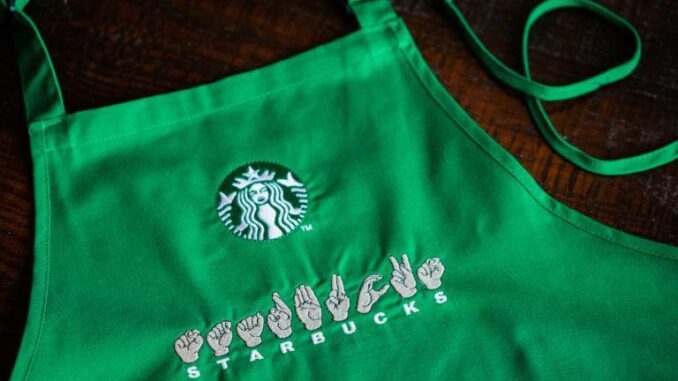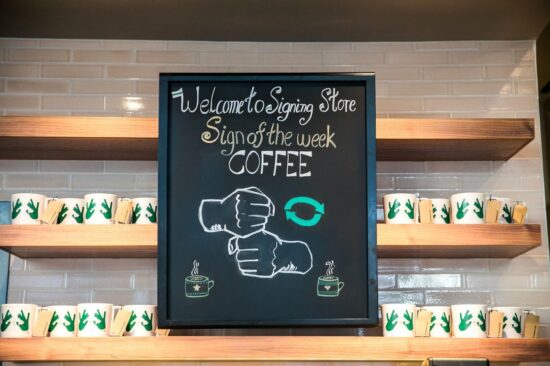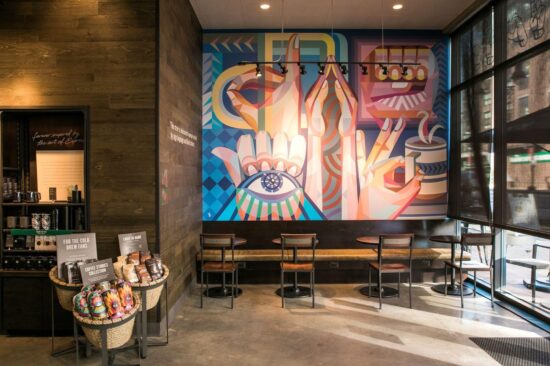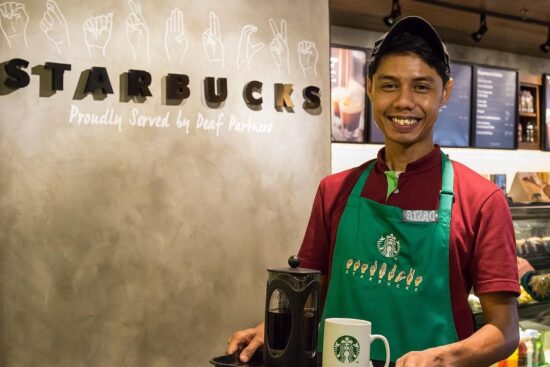
The Signing Stores increase employability rates for the deaf community while educating the hearing world on deaf culture.
BY VASILEIA FANARIOTI
SPECIAL TO BARISTA MAGAZINE ONLINE
Photos courtesy of Starbucks
If you find yourself near Gallaudet University in Washington, D.C., you may stumble upon a unique Starbucks café. This particular store is one of Starbucks’ Signing Stores, designed with the deaf and hard-of-hearing community in mind.
What Signing Stores Look Like
The store is bright and open, with low-glare reflective surfaces and point-of-sale systems with an attached customer display. You approach the counter and are helped by a store partner who is proficient in sign language and wears a special green apron embroidered with the ASL finger-spelling of Starbucks.
The location of the coffee shop is not accidental, as Gallaudet University is a bilingual institution of higher education for deaf and hard-of-hearing individuals through American Sign Language (ASL) and English.

However, what drew my attention to this store was the way in which the deaf and hard-of-hearing community interacted with it. Diversity and inclusion is not a trend, it is a way of life for many of us in today’s society. And surely this Starbucks store is a place to have a coffee, but it’s also a place to learn.
More often than not there is an event going on at the store; there are coffee socials where sign language learners of all levels can come and practice their skills, and discussions in collaboration with local community members such as the Latino Deaf and Hard of Hearing Association of the Metropolitan DC Area, the District of Columbia Area Black Deaf Advocates, and the Deaf and Hard of Hearing Unit of the DC Police Department.
Experiencing Deaf Culture Through Art
What’s more is that these stores provide the hearing world with a chance to experience deaf culture in a more immersive way. Every store features artwork elements and themes designed by deaf and hard-of-hearing artists, such as the mural in the D.C. store created by Yiqiao Wang, a deaf artist and adjunct professor at Gallaudet University.

This Starbucks store is the first Signing Store in the United States; however, the company operates 11 Signing Stores in total. The first one opened in 2016 in Malaysia, and since then locations have popped up in China, the U.S., and most recently in Japan. The D.C. store is an initiative of deaf Starbucks employees, who drew inspiration from the opening of the store in Malaysia.
According to a Starbucks spokesperson, ”We believe that the Signing Store model helps bring the Starbucks Experience to new customers in a relevant and authentic way. As per the National Deaf Center, Deaf and hard-of-hearing people have unemployment rates of 3.8% and 3.4%, respectively. This difference, while small, is statistically significant. Starbucks saw an opportunity to provide a better experience for its Deaf partners (employees).”
Helping Hands
Starbucks is not alone in their efforts; they have the support of the local deaf and hard-of-hearing communities as well as third-party organizations, such as the Society of Interpreters for the Deaf in Malaysia, the Guangdong Deaf People Association in China, and the National Association of the Deaf in the U.S.

The world is becoming more inclusive every day and businesses are playing a big role in that change. Starbucks’ Signing Stores are just one example of how companies are adapting to create a more inclusive environment for all.
Bridging the gap between the deaf and hearing communities not only creates opportunities for those who are often left out, but also creates a learning opportunity for the hearing world. It’s not just about providing a place for the deaf and hard-of-hearing community to gather, but it’s also about educating the hearing world on deaf culture, and how to better communicate with those who are deaf or hard of hearing.
ABOUT THE AUTHOR
Vasileia Fanarioti (she/her) is a freelance copywriter and editor with a primary focus on the coffee niche. She has also been a volunteer copywriter for the I’M NOT A BARISTA NPO, providing content to help educate people about baristas and their work. You can follow her adventures at thewanderingbean.net.

